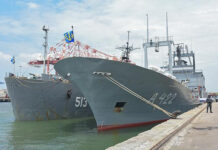Chinese ship Yuan Wang 5, which docked in the Southern Sri Lankan port of Hambatota on Tuesday, has irked India. While China claims it is a research vessel, India says that it is a spy ship. In fact, both these claims are true as the Yuan Wang 5 is a classic example of dual-use technology. It possesses sophisticated capabilities that can be used for a wide-range of civilian and military purposes. WION spoke to Aerospace and Defence sources to understand the possible capabilities of such tracking and support vessels.
As a scientific vessel
During rocket launches, all space agencies track the path of the rocket to understand the mission’s progress. In most cases, tracking is carried out by large antennas on land. However, during special launch missions(interplanetary missions or while using unconventional orbits), a rocket or satellite might not be accessible for tracking from the existing ground stations. In such cases, the spacefaring object would not be visible to the ground stations, and space agencies would place antenna-bearing ships at certain vantage locations at sea, to carry out the tracking. In most cases, such ships are placed at mid-sea locations where there are no ground-based tracking facilities available.
For example, during the launch of India’s Mangalyaan or Mars Orbiter Mission, two antenna-bearing tracking vessels were positioned in the South Pacific ocean. Following the initial phase of the launch that was tracked by the ground stations, it was these ships that tracked the mission’s progress while the spacefaring rocket was zooming in space, over the earth’s vast oceans.
#Chinese spy/“research”vessel (equipped with powerful, long-range radars , sensors) #YuanWang5 entering the #Hambantota port in southern #SriLanka , this morning #india and #USA had been objecting to this ship docking in #lanka , but Lanka budged to #china & results are here! pic.twitter.com/eXoWYqTYhL
— Sidharth.M.P (@sdhrthmp) August 16, 2022
Given China’s ambitious spacefaring activities and their ongoing construction of a space station, it is possible that the Yuan Wang 5 could be used for communicating with their assets in space and to support scientific causes.
As a ‘Scientific Spy’ and a tracking centre
In high-end technology, the lines between civil and military use are blurred. The data that can be collected for civilian use might be extremely useful for the military establishment as well. For example, any country that can make solid-fueled spacefaring rockets will also be equally capable of building missiles, as the fundamental technologies of both hardware are similar.
Likewise, the Yuan Wang 5, with a displacement of more than 25,000 tons, could possess a host of powerful radars, antennae, sensors, and related technologies that could be used for both civilian and military purposes.
The ship’s powerful radars indicate that they can track and analyse the paths of rockets, satellites and even missiles. In addition to this, the Yuan Wang can conduct surveillance at sea, on land(as far as its radar can penetrate) and also below the surface of the water.
The water in every ocean has its own set of unique characteristics, and the precise data about this can enhance the warfare capabilities of a naval force. It goes without saying that the waters of the Indian Ocean have characteristics that are vastly different from those of the Pacific Ocean.
Several parameters, such as water salinity, ocean temperature, sound wave propagation in water, and so on, aid in understanding the operating conditions and making appropriate preparations.Possessing such data can also help calibrate existing sensors and technology for precise operation of various systems and sub-systems.
Gathering Electronic Intelligence
With advanced sensors, a vessel like Yuan Wang 5 can also monitor and record the unique acoustic signatures of enemy ships and submarines, thus helping Chinese warships identify their rivals at sea and beneath the surface. This is also done by gathering the signals emitted by mobile assets and military bases/facilities. Such methods help understand the deployment of enemy vessels, aircraft, and assets and can help establish a pattern of their activity.
What does this mean for India?
Given the long-range tracking capabilities of the Chinese ship, it must be noted that India’s spaceport in Sriharikota, the missile test range in Odisha, and several other military facilities in the peninsular region could possibly be within tracking range of the visiting vessel, or those facilities could be tracked as the ship sails to Hambantota and back.
India is concerned about the growing presence of China in the Indian Ocean region and the increasing influence of China in Sri Lanka. Sri Lanka owes a significant debt(around 10% of Sri Lanka’s foreign debt) to China, as several big-ticket infrastructure projects were built in Sri Lanka using Chinese loans. Meanwhile, India has provided close to $3.8 billion in aid to the island nation that is reeling under its worst-ever economic crisis.
Despite concerns raised by both India and the US, the Chinese ship has sailed into the Chinese-run Hambantota port in the island nation. The ship sailed in on August 16th, just a day after India gifted Sri Lanka a Dornier Maritime Surveillance Aircraft.
Written By: Sidharth MP
(IST)





